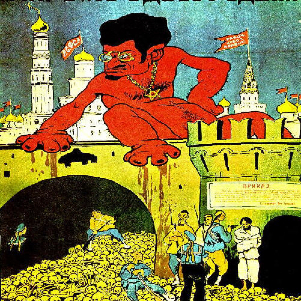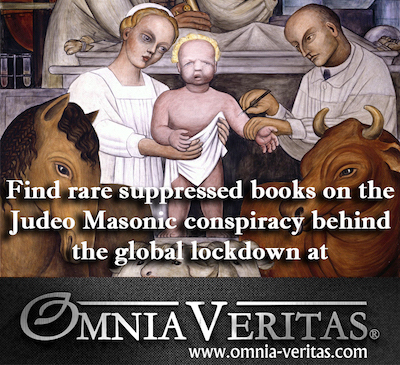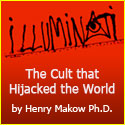Book Details Communist War on Christianity
September 21, 2011
 left, Contemporary image of the Illuminati Jew Trotsky murdering Russian Christians.
left, Contemporary image of the Illuminati Jew Trotsky murdering Russian Christians. Professor Andrei Burovsky's book Myths and the Truth about 1937: Stalin's Counter-Revolution (YAZA-PRESS, Moscow, 2010 defends Stalin's 1937 purge ("The Great Terror") saying it was designed to cleanse the USSR of Jewish domination. (This presaged the holocaust.) The Jews led by Trotsky regarded Stalin as an impediment to the Rothschild's plan for world government.
Review by Dan Michaels in Occidental Observer
(abridged/edited by henrymakow.com)
Andrei Burovsky says the genocide committed by Bolshevik Jews in Russia far exceeded anything known to date.
During the revolution, no fewer than two million Russians Christians met their death. In the continuing period of internal civil war, Burovsky estimates 9-13 million eventually lost their lives.
Yet, the crimes of the Lenin-Trotsky faction were either glossed over or simply not mentioned in the press or on the radio, while the Western media concentrated on and exaggerated those committed by Stalin in 1937 during the "Great Purge."
According to Burovsky, the [satanist, Cabalist] Leninists and Trotskyites made no secret of their intent to create a new world on the ashes of the old. In their anthem, The Song of the Destroyers, they sing:
We shall burn everything, we shall destroy everything,
We shall wipe everything from the face of the Earth,
We shall extinguish the old Sun,
We shall ignite a new Sun. (p. 155)
Lenin and Trotsky, Burovsky maintains, invented and practiced genocide freely in what they termed the "zoological milieu", i.e., the Russian people, ruthlessly murdering entire layers of Russian society.
As soon as members of the former ruling class (high government officials, generals, intellectuals, clergy, etc.) were eliminated, their positions were filled with Jewish revolutionaries.
The children of the former upper classes were forbidden to attend the best schools and universities; only the children of the revolutionaries were granted access. According to Jewish World, 1939, Jews, representing 1.8% of the total population, constituted 20% of the students in higher institutes of learning in the USSR in 1939.[4] (p. 230)
The destruction of Christian civilization was high on Lenin and Trotsky's hit list. All displays of Christian belief were outlawed. Churches were first looted of their art treasures and then converted into warehouses, theaters, recreation centers, and worse. Priests, nuns, and all other officers of the Church were either murdered or sent to the Gulag.
Celebrations of Christmas, Easter, and Holy Days were forbidden. The icon corner in most Russian homes was banned. Because Jews were prominent among the new rulers and enforcers, all acts of anti-Semitism were made punishable by death.
In a speech, Trotsky announced the unveiling of the first statue in the world of Judas Iscariot, a man, the Communist leader said, who understood that Christianity was a phony religion and had the courage to break the bonds that bound him to it. Similar statues appeared in other cities. The people, however, could not protest because of the laws against anti-Semitism.
CULTURE WAR
Burovsky describes how the revolutionaries tried to gradually replace the civilization achieved under the Orthodox Church and the Czars with something entirely alien to the native people.
Under the Czars, Russia gave the world Pushkin, Dostoyevsky, Tolstoy, and other giants of literature. By way of contrast, the Communist regime produced a bevy of poets and short story writers. Burovsky singles out Osip Mandelshtam, Yevgenia Ginzburg, and Isaak Babel, who lent their services to the new regime.
Mandelshtam, who was a friend of Bukharin, had worked in the ministry of education of the new regime. Babel had actually served in the Jewish-dominated Cheka for many years and wrote almost autobiographically about his experiences in his stories. He was also the mentor of Ilya Ehrenburg, World War II's most notorious propagandist.
Both enjoyed life and indulged in the pleasures of the Arbat. Both were executed in Stalin's 1937 counter-revolution. Burovsky and the mass of Russian people would maintain that they got what they deserved.
Under the Czars and the Orthodox Church Russia gave the world the paintings of Repin, Rublov, and other such immortals. The Communist regime, on the other hand, introduced abstract "art" produced by such worthies as Kandinsky, Malevich, Altman, Chagall, Shterenburg, and other such.
Again, Stalin, like Hitler, preferred socialist realism in art. Whatever the objective merits of the works produced by the artists and literary figures in the early Soviet Union, they reflected the Jewish, not the Russian spirit.
ARMY PURGE
Proceeding then to Stalin's purge of the Red Army leadership and the NKVD, Burovsky finds much to be applauded. Although Generals Zhukov and Rokossovsky believed that Stalin's purge had broken the spine of the Red Army and was responsible for the losses in the first years of World War II, Burovsky leans more to the views expressed by Viktor Suvorov in his book The Purge,[5] namely that the purge or cleansing actually improved the Red Army by removing toxic and incompetent elements.
Moreover, Trotsky, as first head of the Army and Navy, had appointed many of the top military leaders. Obviously, Stalin considered them tainted and their loyalty to him questionable.[6]
Stalin purged the organs of State security (Cheka, NKVD), notoriously Jewish strongholds, with a particularly heavy and rough brush. According to Burovsky, about 20,000 members of these organs were purged, including almost all the leaders of the Dzerzhinski era: A. Kh. Artuzov, G. I. Boky, M. Ya. Latsis, M. S. Kedrov, V. N. Mantsev, G. S. Moroz, I. P. Pavlunovsky, Ya. Kh. Peters, M. A. Trilisser, I. S. Unshlikht, and V. V. Fomin. Of this Burovsky comments: "It would be difficult to imagine a more repulsive, criminal, and dangerous group of people." (Diky, p. 240) Nikolai Yezhov, known to insiders as the "bloody dwarf" because he was only five feet tall, was commissar general of state security in charge of both the NKVD and the GRU. He was arrested in January 1939 and shot in April 1940.
TROTSKY STAFFED THE ARMY
In 1919, at the onset of the Civil War (1917-1922) Trotsky was made Peoples Commissar of Army and Navy, head of the Red Army. For a decade in that and other high posts, Trotsky was in a prime position to fill the armed forces and government with his own people, mostly Jews, often despite Stalin's disapproval.
During the same period, Stalin by virtue of his position as Party Secretary, a less prominent but equally important position, had also been putting his own people in critical posts. In 1929, Stalin finally succeeded in exiling Trotsky, but his competitor's shadow lingered on. Thus, the Communist Party and state in the late 1930s still remained, as most objective observers noted, essentially Jewish.
For example, in 1937 almost without exception the plenipotentiaries (ambassadors) of the Soviet Union to the rest of the world were Jews: Maisky in England, Surits in France, Yurenev in Germany, Shtein in Italy, and Rubinin in Belgium. The Soviet Delegates to the League of Nations were with one exception Jews: Finkelshtein-Litvinov, Rozenberg, Shtein, Markus, Brenner, Girshfeld, Galfand, and Svanidze who was Georgian. Litvinov was also head of the Commissariat of Foreign Affairs. (Diky, p. 222)
At the time of the Spanish Civil War (1936-1939), the Soviet Ambassador was Marcel Rozenberg; the military attaché was Lvovich (pseudonym Loti). The Red Army officers commanding the international brigades were: Division Commander Lazar Shtein (Emil Kleber); other Jewish commanders were Grigori Shtein (Grigorovich), Corps CommanderYakov Smushkevich (Duglas), Red Army General Batkin (Fritz), and others. Abram Slutsky (Chernigovsky), head of the Soviet Foreign Intelligence Service, NKVD, also came and joined with resident NKVD agent General Aleksandr Orlov who supervised a private jail in Alkalade. (Diky, p. 223)
Soon after World War II and the founding of the state of Israel, Stalin, following a policy of Russification and rejuvenation of the victorious Communist State, attempted once again to reduce the number and power of Jews in the Soviet Union. To this end, he planned another purge, one that would necessarily involve many of his old Jewish comrades. Before he could implement his plan, he was dead. Officially the Soviet leader was reported to have died a natural death, but many speculate that he was killed by the people he had planned to kill.[8]
.
Endnotes:
[1] "Glorious 1937!", Zavtra, 9 September 1997. The Russian national heroes are: General Aleksandr Suvorov, General Mikhail Kutuzov, Admiral Pavel Nakhimov, and Admiral Fyodor Ushakov. The Knight in the Tiger's skin is Prince Tariel of India, from the famous Georgian poem Vephkhviskhaosani.
[4] Andrei Diky. 200 Years Together: Jews in Russia and the USSR. Algoritm Publishing, Moscow, 2010, 320 p.
[5] Suvorov uses the Russian word ischishchenie instead of the usual chistka for "purge." The former has more the meaning of "cleansing" or the removal of toxic, dangerous elements; the later has more the meaning of total housecleaning. Robert Conquest preferred to use the expression The Great Terror rather than The Great Purge. Like so many of his contemporaries at Oxford, Conquest himself joined the Communist Party in "glorious 1937."
[6] Dan Michaels. Stalin's 1937 Purge of the Red Army. The Barnes Review, No. 3, 2000, pp. 49-55.
[8] Dan Michaels [aka as Robert Logan]. Was Stalin Assassinated? The Barnes Review, No. 4, 2003, pp. 35-40.
--
Related- Rothschild Conducts Red Symphony
Makow Comment: In his infatuation with Stalin, Burovsky skips over the ten million Ukrainians Stalin starved to death. Also, he doesn't explain the many Jews like Lazar Kaganovitch who organized the famine, and remained allied to Stalin long after 1937. Stalin was married to his sister. I see 1937 as an internecine struggle over who will control the NWO.
Thanks to William for sending this.







Ed said (September 23, 2011):
I think that trying to favorably compare Stalin to Lenin and Trotsky is like trying to favorably compare Al Capone with Bugs Moran; those people were conspirators and killers, and that pretty well sums it up. The only good thing about Stalin is that he was more concerned with dominating his own milieu than he was with spreading his control everywhere, so that his policies wound up crippling Soviet Russia and making the worldwide conquest envisioned by the Trotskyites impossible---and that's not much of a "good thing," when you consider the tens of millions of Soviet citizens of all ethnicities who met their ends because of Stalin's psychopathic paranoia.
The events of that period are now of course more and more open to debate, mainly because the direct witnesses have by now almost all passed on. But we still have film, which often shows you things in a way impossible to write down. I once saw a clip of the end of a speech given by Stalin during the late 1940s. When the great man finished speaking, everyone in the auditorium immediately stood up and started clapping. This continued for precisely three minutes, when an electric buzzer went off, and everyone stopped clapping simultaneously. This was necessary, because if they stopped clapping spontaneously, the ones who stopped first could be suspected of disloyalty, and perhaps be arrested later on. That film clip told me more about life in Stalin's Soviet Union than whole volumes of non-fiction.